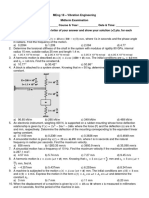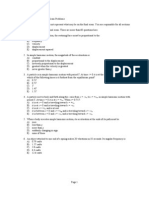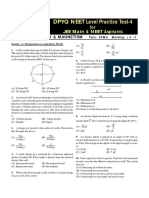0 ratings0% found this document useful (0 votes)
60 viewsModel (A)
Model (A)
Uploaded by
omar7araz1. The document appears to be an exam for a Physics course taken by a Mechanical Engineering student at Helwan University in Cairo, Egypt.
2. The exam contains 25 multiple choice questions related to physics concepts like simple harmonic motion, wave propagation, sound waves, and more.
3. The questions assess understanding of key variables that describe oscillatory and wave motions like amplitude, wavelength, frequency, speed, and their relationships.
Copyright:
© All Rights Reserved
Available Formats
Download as PDF, TXT or read online from Scribd
Model (A)
Model (A)
Uploaded by
omar7araz0 ratings0% found this document useful (0 votes)
60 views2 pages1. The document appears to be an exam for a Physics course taken by a Mechanical Engineering student at Helwan University in Cairo, Egypt.
2. The exam contains 25 multiple choice questions related to physics concepts like simple harmonic motion, wave propagation, sound waves, and more.
3. The questions assess understanding of key variables that describe oscillatory and wave motions like amplitude, wavelength, frequency, speed, and their relationships.
Copyright
© © All Rights Reserved
Available Formats
PDF, TXT or read online from Scribd
Share this document
Did you find this document useful?
Is this content inappropriate?
1. The document appears to be an exam for a Physics course taken by a Mechanical Engineering student at Helwan University in Cairo, Egypt.
2. The exam contains 25 multiple choice questions related to physics concepts like simple harmonic motion, wave propagation, sound waves, and more.
3. The questions assess understanding of key variables that describe oscillatory and wave motions like amplitude, wavelength, frequency, speed, and their relationships.
Copyright:
© All Rights Reserved
Available Formats
Download as PDF, TXT or read online from Scribd
Download as pdf or txt
0 ratings0% found this document useful (0 votes)
60 views2 pagesModel (A)
Model (A)
Uploaded by
omar7araz1. The document appears to be an exam for a Physics course taken by a Mechanical Engineering student at Helwan University in Cairo, Egypt.
2. The exam contains 25 multiple choice questions related to physics concepts like simple harmonic motion, wave propagation, sound waves, and more.
3. The questions assess understanding of key variables that describe oscillatory and wave motions like amplitude, wavelength, frequency, speed, and their relationships.
Copyright:
© All Rights Reserved
Available Formats
Download as PDF, TXT or read online from Scribd
Download as pdf or txt
You are on page 1of 2
Helwan University 1st √ Academic year
Faculty of Engineering – Mataria – Cairo 2nd 2022/2023
First Year Mechanical Engineering Programs Date of Exam: 22/1/2023
Course Name: Physics (3) Time allowed: 3 Hours
Course Code: BSE102 كلية الهندسة بالمطرية Maximum Degree: 50 Marks
Student Name: ………………………………. Student ID ...…………………
Model A
MCQ: Choose the correct answer after making suitable calculations for the following:
1) The motion of a particle connected to a spring is described by 𝒙 = 𝟏𝟎 𝐬𝐢𝐧(𝝅𝒕). At what time in seconds is
the potential energy equal to the kinetic energy?
a) 0.25 b) 0.50 c) 0.79 d) 1.0
2) A particle executing SHM has velocities 20 cm/s and 16 cm/s at displacements 4 cm and 5 cm from its
equilibrium position, respectively. Its time period is
a) π/2 s b) π s c) 2π s d) π/4 s
3) A lightly damped harmonic oscillator, with a damping force proportional to its speed, is oscillating with
an amplitude of 0.500 cm at time t = 0. When t = 8.20 s, the amplitude has died down to 0.400 cm. At what
value of t will the oscillations have an amplitude of 0.250 cm?
a) 5.13 s b) 16.5 s c) 20.5 s d) 25.5 s
4) An object of mass 2.0 kg hangs from an ideal massless spring with a spring constant of 50 N/m. An
oscillating force 𝑭𝒇 = (𝟓 𝑵) 𝐜𝐨𝐬[(𝟒 𝒓𝒂𝒅/𝒔)𝒕] is applied to the object. The damping constant is 0.02 Kg/s.
What is the amplitude of the resulting oscillations?
a) 0.15 m b) 0.8 m c) 0.28 m d) 1.6 m
5) A mass of 4 Kg is attached to a spring that has a spring constant equal to 800 N/m. The damping constant
that is required to produce c
ritical damping is
a) 0.57 Kg/s b) 56.57 Kg/s c) 113.14 Kg/s d) 1600 Kg/s
6) A body of mass 2 Kg is attached to a spring with a spring constant of 200 N/m. A driving periodic force is
applied to the object for producing forced oscillations. The forced displacement of the object is described
by 𝒙(𝒕) = (𝟔 𝐜𝐦) 𝐜𝐨𝐬[(𝟐𝝅 𝒓𝒂𝒅/𝒔)𝒕 + 𝝋𝒐 ]. The damping constant is 8 Kg/s. What is the phase angle 𝝋𝒐 of
the forced motion?
a) – 22.55° b) – 162.7° c) – 8.2° d) – 171.5°
7) A standing wave having three nodes is set up in a string fixed at both ends. If the frequency of the wave is
doubled, how many antinodes will there be?
a) 2 b) 3 c) 4 d) 6
8) A transverse sinusoidal wave on a string has a period T = 0.025 s and travels in the negative x direction
with a speed of 30.0 m/s. At t = 0, an element of the string at x = 0 has a transverse position of 2.00 cm and
is traveling downward with a speed of 2.00 m/s. What is the amplitude of the wave?
a) 0.2 m b) 0.4 m c) 0.02 m d) 0.04 m
9) A 0.25 Kg object attached to a spring executes light damping oscillations with damping constant 2 Kg/s. It
is found that the amplitude is reduced by one third of its initial value for each cycle. What is the damping
angular frequency?
a) 32 rad/s b) 62 rad/s c) 78 rad/s d) 93 rad/s
10) The kinetic energy KE, in Joule, in an ideal mass spring system is given by KE = 144 – 9x2, where x is the
position of the moving mass, in meter, with respect to the equilibrium position. What is the amplitude of
the motion?
a) 2 m b) 3 m c) 4 m d) 5 m
11) A 10.6 Kg object oscillates at the end of a vertical spring that has a spring constant of 2.05×10 4 N/m. The
effect of air resistance is represented by the damping coefficient b = 3 Kg/s. By what percentage does the
amplitude of the oscillation decrease in each cycle?
a) 1 % b) 2% c) 3 % d) 4 %
12) The function 𝒚(𝒙, 𝒕) = (𝟏𝟓. 𝟎 𝒄𝒎) 𝐜𝐨𝐬(𝝅𝒙 − 𝟏𝟓𝝅𝒕), with x in meters and t in seconds, describes a wave on
a taut string. What is the transverse speed for a point on the string at an instant when that point has the
transverse displacement y = 12.0 cm?
a) 1.25 m/s b) 2.54 m/s c) 4.24 m/s d) 6.37 m/s
13) Use the linear wave equation to find the propagation speed of the travelling wave 𝒚(𝒙, 𝒕) =
𝟑𝟎 (𝟎. 𝟖𝒙 + 𝟐𝒕)−𝟐 where x and y are in meters and t is in seconds.
a) 5.58 cm/s b) 9.33 cm/s c) 40 cm/s d) 250 cm/s
14) Two waves 𝒚𝟏 and 𝒚𝟐 travel along the same string: 𝒚𝟏 (𝒙, 𝒕) = (𝟒. 𝟔𝟎 𝒎𝒎) 𝐜𝐨𝐬 (𝟐𝝅𝒙 − 𝟒𝟎𝟎𝝅𝒕) &
𝝅
𝒚𝟐 (𝒙, 𝒕) = (𝟒. 𝟔𝟎 𝒎𝒎) 𝐜𝐨𝐬 (𝟐𝝅𝒙 − 𝟒𝟎𝟎𝝅𝒕 + ), where x is in centimeters and t is in seconds. What is the
𝟒
amplitude of the resultant wave?
a) 0.92 cm b) 0.85 cm c) 0.42 cm d) 0.35 cm
15) A standing wave is formed on a taut string of length 4.35 m and mass 2 gm. The string is stretched by a
weight of 0.19 Kg. What is the frequency of the fourth overtone?
a) 29.26 Hz b) 36.57 Hz c) 1.16 Hz d) 0.93 Hz
16) Transverse waves are generated in two uniform steel wires A and B by attaching their free end to a
vibrating source of frequency 500 Hz. The diameter of wire A is half that of wire B and the tension on wire
A is half that on wire B. what is ratio of the velocity of waves in wires A and B?
a) 2 b) 4 c) √𝟐 d) √𝟖
17) A platinum wire that is 1.20 m long has a radius of 0.500 mm and is fixed at both ends. In its third
3 3
harmonic it vibrates at 512 Hz. The density of platinum is 21.4 × 10 kg/m . What is the tension in the wire?
a) 4 KN b) 2.82 KN c) 1.41 KN d) 1 KN
18) Standing waves of frequency 57 Hz are produced on a string that has mass per unit length 0.0160 kg/m.
With what tension must the string be stretched between two supports if adjacent nodes in the standing
wave are to be 0.71 meters apart?
a) 6.6 N b) 26.2 N c) 80.3 N d) 104.8 N
19) A string along which waves can travel is 2.7 m long and has a mass of 260 g. The tension in the string is 36
N. What must the frequency of traveling waves of amplitude 7.7 mm for the average power to be 85 W?
a) 2.4 Hz b) 35.12 Hz c) 197.5 Hz d) 279.6 Hz
20) Two cars A and B are moving away from each other in opposite directions. Both the cars are moving with a speed
of 20 m/s with respect to the ground. If an observer in car A detects a frequency 2000 Hz of the sound coming from
car B, what is the natural frequency of the sound source in car B? (Speed of sound in air = 340 m/s)
a) 2250 Hz b) 2060 Hz c) 2150 Hz d) 2300 Hz
21) What is the amplitude of vibration of the particles of air through which a sound wave of intensity 2.0×10−6 W/m2 and
frequency 1.0 kHz is passing? (Density of air = 1.2 kg/m3 and speed of sound in air = 330 m/s)
a) 4.4 × 10−8 m b) 1.6 × 10−8 m c) 2.4 × 10−6 m d) 1.8 × 10−6 m
22) At a distance of 2.00 m from a point source of sound, the intensity level is 80.0 dB. What will be the
2
intensity level at a distance of 4.00 m from this source? The lowest detectable intensity is 10-12 W/m .
a) 77 dB b) 74 dB c) 60 dB d) 40 dB
23) A pipe that is 20.0 m long and 10.0 cm in diameter contains olive oil. The density of the olive oil is 890
3 9
kg/m and the bulk modulus is 1.3 × 10 Pa. A 3.4 Hz longitudinal wave is transmitted in the oil. How many
milliseconds does it take for the wave to travel the length of the pipe in the oil?
a) 16.5 ms b) 14.6 ms c) 12.3 ms d) 8.7 ms
24) As you stand by the side of the road, a car approaches you at a constant speed, sounding its horn, and
you hear a frequency of 80.0 Hz. After the car goes by, you hear a frequency of 60.0 Hz. What is the speed
of the car? The speed of sound in the air is 343 m/s.
a) 64 m/s b) 49 m/s c) 36 m/s d) 25 m/s
25) If the amplitude of sound is doubled and the frequency reduced to one-fourth, the intensity of sound at the
same point will be
a) Increasing by a b) Decreasing by a c) Decreasing by a d) Unchanged
factor of 2 factor of 2 factor of 4
You might also like
- Math 7 Second Quarterly AssessmentDocument3 pagesMath 7 Second Quarterly AssessmentKim Kim100% (2)
- Electricity Practice TestDocument8 pagesElectricity Practice TestMani MNo ratings yet
- wave motionDocument33 pageswave motionshashankthegreateNo ratings yet
- PHY101 MidTerm MCQs by Talha SajidDocument75 pagesPHY101 MidTerm MCQs by Talha SajidAfshanNo ratings yet
- MULTIPLE CHOICE. Choose The One Alternative That Best Completes The Statement or Answers The QuestionDocument7 pagesMULTIPLE CHOICE. Choose The One Alternative That Best Completes The Statement or Answers The QuestionamberNo ratings yet
- Mock Exam PDFDocument12 pagesMock Exam PDFRayyan SalmanNo ratings yet
- Problem Set Unit 2ADocument3 pagesProblem Set Unit 2AKool PrashantNo ratings yet
- Physics - 2 - Practice Without AnswerDocument10 pagesPhysics - 2 - Practice Without AnswerTuấn Nguyễn TrịnhNo ratings yet
- BSNL Tta Exam PaperDocument8 pagesBSNL Tta Exam PaperRajnish Chandra Prasad100% (1)
- 1 DPPDocument14 pages1 DPPManthan ChaudharyNo ratings yet
- PHY101 MidTerm MCQs by Talha SajidDocument84 pagesPHY101 MidTerm MCQs by Talha SajidTalha SajidNo ratings yet
- JET Model Test PaperDocument39 pagesJET Model Test PaperParallax CubingNo ratings yet
- MEng 18 - Mid Term Exam ADocument2 pagesMEng 18 - Mid Term Exam Aje solarteNo ratings yet
- Sample FinalDocument15 pagesSample FinalGeoff HattNo ratings yet
- aliyou (1)Document11 pagesaliyou (1)Miguel FotsoNo ratings yet
- Final PhysicsREVISEDDocument6 pagesFinal PhysicsREVISEDalecksander2005No ratings yet
- Waves 1Document5 pagesWaves 1Shiva Ram Prasad PulagamNo ratings yet
- Ned Physics 2024 RecreationDocument9 pagesNed Physics 2024 Recreationhassankhan032370No ratings yet
- Physic Source 101Document22 pagesPhysic Source 101xander furioNo ratings yet
- New Sheets of Physics II (Navigation) - 030150Document28 pagesNew Sheets of Physics II (Navigation) - 030150dolagya800No ratings yet
- Phy Xi Practice WorksheetDocument5 pagesPhy Xi Practice Worksheetpoonamrathi83.prNo ratings yet
- Phys2325 Final Exam Ch10-16Document4 pagesPhys2325 Final Exam Ch10-16schelankoNo ratings yet
- Worksheet Vibration and WavesDocument3 pagesWorksheet Vibration and WavesHindNo ratings yet
- Wave Questions for Dina11Document12 pagesWave Questions for Dina11devil32gamerNo ratings yet
- 14 - Periodic MotionDocument6 pages14 - Periodic MotionNKHICQ1mEbIwNo ratings yet
- Assignment For Final Term Spring 2019-20. - 2Document2 pagesAssignment For Final Term Spring 2019-20. - 219-40122-1No ratings yet
- Phycisc Mdcat PMC Full BookDocument5 pagesPhycisc Mdcat PMC Full BookMuhammad TariqNo ratings yet
- UPSEE - 2000 Full Paper: Section-1 PhysicsDocument0 pagesUPSEE - 2000 Full Paper: Section-1 PhysicsAbhay Upadhyay100% (1)
- Physics Portion PIEAS 2013Document3 pagesPhysics Portion PIEAS 2013Shahzaib Arain100% (1)
- PHY-GQ-WAVE-1Document24 pagesPHY-GQ-WAVE-1Educated gamingNo ratings yet
- Prize TesttDocument2 pagesPrize TesttKashif MagsiNo ratings yet
- XI ECR PHY NEET WPT 02.12.24Document4 pagesXI ECR PHY NEET WPT 02.12.24Deena chemistNo ratings yet
- FLP PhysicsDocument4 pagesFLP PhysicszzarghamNo ratings yet
- NYC ExamplesDocument30 pagesNYC ExamplesKianoosh BaghiNo ratings yet
- Ondas MecanicasDocument2 pagesOndas MecanicasJesús De La Ossa0% (2)
- Gen Physics 1 2nd Quarter ExamDocument9 pagesGen Physics 1 2nd Quarter ExamAldrin AbilayNo ratings yet
- Grand Test-1 PhysicsDocument6 pagesGrand Test-1 Physicsnavothithajeyaram123No ratings yet
- Honors Physics Spring Semester Exam - June 2021 - Period 3Document7 pagesHonors Physics Spring Semester Exam - June 2021 - Period 3Olivia CaffreyNo ratings yet
- Simple Harmonic Motion Worksheet 2: Kaplan International Pathways 1Document1 pageSimple Harmonic Motion Worksheet 2: Kaplan International Pathways 1NadeenMohamedNo ratings yet
- Document 1Document15 pagesDocument 1umesh260300No ratings yet
- 5 Wave Motion & SoundDocument32 pages5 Wave Motion & Soundhamza00715No ratings yet
- Review Exam 3-NewDocument18 pagesReview Exam 3-NewhtyhongNo ratings yet
- Moving Charges and Magnetism AnsDocument2 pagesMoving Charges and Magnetism AnsxoxosowmyaNo ratings yet
- Tutorial 2 sscp1163Document2 pagesTutorial 2 sscp1163Nur SyahirahNo ratings yet
- Gr11 Physics FpeDocument42 pagesGr11 Physics FpeHoàn Nguyễn NgọcNo ratings yet
- Noise and Vibrations Question BankDocument19 pagesNoise and Vibrations Question BankAbhijit DakareNo ratings yet
- CH 16Document12 pagesCH 16Qassem MohaidatNo ratings yet
- UPSEE - 2000 Full Paper: Section-1 PhysicsDocument50 pagesUPSEE - 2000 Full Paper: Section-1 Physicsramendra100% (1)
- WAVES-1Document147 pagesWAVES-1itsayushi440No ratings yet
- Standing WavesDocument2 pagesStanding WavespedroNo ratings yet
- AIIMS - Mbbs Entrance Sample Question PaperDocument24 pagesAIIMS - Mbbs Entrance Sample Question PaperrichuNo ratings yet
- HomeWork 04Document4 pagesHomeWork 04Jennifer PadillaNo ratings yet
- Waves XiDocument4 pagesWaves XiSachin AgarwalNo ratings yet
- Phys 125 Pex 5Document9 pagesPhys 125 Pex 5Richard OuNo ratings yet
- PHYS_369_F2019_Final_exam_to_printDocument17 pagesPHYS_369_F2019_Final_exam_to_printmz9546418No ratings yet
- String WavesDocument8 pagesString WavesArsh DhawanNo ratings yet
- Iut Admission Test 2016.2017 Question Paper: PhysicsDocument13 pagesIut Admission Test 2016.2017 Question Paper: PhysicsAhsan Habib TanimNo ratings yet
- O level Physics Questions And Answer Practice Papers 2From EverandO level Physics Questions And Answer Practice Papers 2Rating: 5 out of 5 stars5/5 (1)
- O level Physics Questions And Answer Practice Papers 3From EverandO level Physics Questions And Answer Practice Papers 3Rating: 3 out of 5 stars3/5 (1)
- Rotational MotionDocument13 pagesRotational Motionnikog2ezNo ratings yet
- Physics Assigment 1Document14 pagesPhysics Assigment 1maroofjahanaziziNo ratings yet
- 750 Blockbuster Problems in Physics - Disha Experts - RemovedDocument8 pages750 Blockbuster Problems in Physics - Disha Experts - Removedlalithasaranya018No ratings yet
- 1 Heat Transfer 2021Document40 pages1 Heat Transfer 2021elking.ahmed1562002No ratings yet
- Schedule & Syllabus of Mian Written Examination For CGLRE Specialist 2023Document29 pagesSchedule & Syllabus of Mian Written Examination For CGLRE Specialist 2023Akash KumarNo ratings yet
- Amplitude and Phase Synthesis of Loudspeaker SystemsDocument8 pagesAmplitude and Phase Synthesis of Loudspeaker SystemsAbelardo AlvarezNo ratings yet
- Current Rating and Emergency CalculationDocument14 pagesCurrent Rating and Emergency Calculationm3eenNo ratings yet
- Class 12 Physics Investagatory ProjectDocument2 pagesClass 12 Physics Investagatory ProjectAmina KhanNo ratings yet
- Testing Methods For Fertilizers 2019Document759 pagesTesting Methods For Fertilizers 2019azhaniNo ratings yet
- Astm D 1434-1982 Old Method Otr TestDocument12 pagesAstm D 1434-1982 Old Method Otr Testjai soniNo ratings yet
- CDB 4323 Assignment 2Document7 pagesCDB 4323 Assignment 2Muhammad AnwarNo ratings yet
- #NEET DPYQ Test Paper - 4 - Electricity & MagnetismDocument8 pages#NEET DPYQ Test Paper - 4 - Electricity & MagnetismZombie GamerNo ratings yet
- Sop 1 Calibration Certificate Preparation 20180213Document9 pagesSop 1 Calibration Certificate Preparation 20180213SKPACA100% (1)
- Kautilya Physics NotesDocument27 pagesKautilya Physics NotesMOHD zAIDNo ratings yet
- Etank Full ReportDocument52 pagesEtank Full ReportMarcos ArbizaNo ratings yet
- Motion in Straight LineDocument28 pagesMotion in Straight LineSuresh ShahNo ratings yet
- ASSIGNMENT Work, Energy and PowerDocument3 pagesASSIGNMENT Work, Energy and PowerMary Jane NogalesNo ratings yet
- Automated Measurement of Maturity, Fineness, Ribbon Width, and Micronaire of Cotton FibersDocument7 pagesAutomated Measurement of Maturity, Fineness, Ribbon Width, and Micronaire of Cotton FibersProvocateur SamaraNo ratings yet
- 17HDN SERIES 1.8°: Key FeaturesDocument5 pages17HDN SERIES 1.8°: Key FeaturesCarlos BaezNo ratings yet
- Tesla meter,Gauss meter、Magnetic flux densimeter、Introduction Handy typeDocument2 pagesTesla meter,Gauss meter、Magnetic flux densimeter、Introduction Handy typesomkiat kongprasiatNo ratings yet
- B.Tech VII Semester: Lecture Notes ONDocument221 pagesB.Tech VII Semester: Lecture Notes ONAneeshNo ratings yet
- Full How To Use A Multimeter How To Measure Current Voltage and Resistance With Your Digital Multimeter 1st Edition Erik Smith Ebook All ChaptersDocument39 pagesFull How To Use A Multimeter How To Measure Current Voltage and Resistance With Your Digital Multimeter 1st Edition Erik Smith Ebook All Chaptersmotojichunho100% (8)
- Commercial Gas Meter G10: Exact Measurement and SecurityDocument1 pageCommercial Gas Meter G10: Exact Measurement and SecurityRoberto LeónNo ratings yet
- Gcse Circuits1 MSDocument18 pagesGcse Circuits1 MSsciencedocsmanNo ratings yet
- Module-2Document12 pagesModule-2DomsmillaresNo ratings yet
- Chapter Test Answers Physics 12Document35 pagesChapter Test Answers Physics 12sawanyadav3010No ratings yet
- Chapter 11 - Calorimetry - Selina Solutions Concise Physics Class 10 ICSE - KnowledgeBoatDocument70 pagesChapter 11 - Calorimetry - Selina Solutions Concise Physics Class 10 ICSE - KnowledgeBoatskjNo ratings yet
- A K Children Academy, Raj Nagar Extn. Session 2021-22 Revision Worksheet SUBJECT Physics (042), CLASS XI Chapter 9 (Mechanical Properties of Solids)Document11 pagesA K Children Academy, Raj Nagar Extn. Session 2021-22 Revision Worksheet SUBJECT Physics (042), CLASS XI Chapter 9 (Mechanical Properties of Solids)Aditya BhatiNo ratings yet

























































































